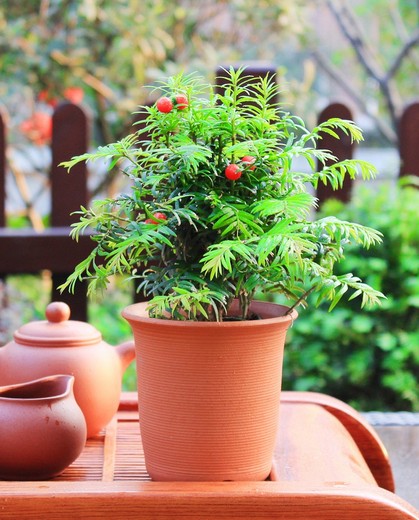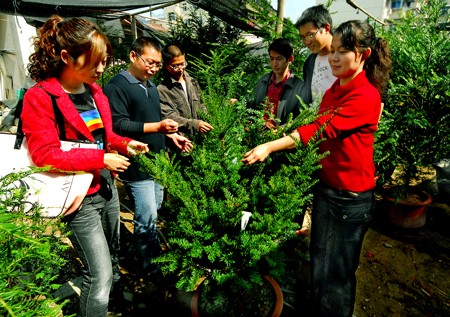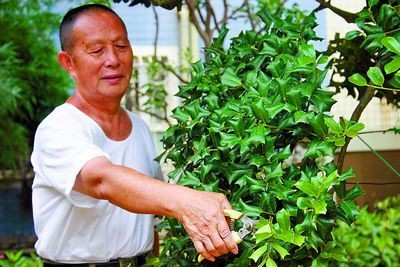The watering method of yew bonsai: if it is not dry, it will be watered thoroughly.
Water is an important part of flowers and trees, all life activities of flowers and trees should be carried out with the participation of water, whether photosynthesis or transpiration, can not be separated from water, water can maintain the swelling and pressure of cells and make branches and leaves straight. But beyond the limit, the plant growth is thin and weak, such as long-term basin soil too much water, it will cause leaves yellowing, deciduous leaves, rotten roots, and even death.

1. Look at the slightly lighter color on the surface of the basin soil, the leaves slightly curl, press the basin soil with your fingers and feel a little soft, and when the sound from tapping the middle and upper part of the basin body with finger joints is relatively dull, the basin soil does not need to be watered, as long as the leaf surface is sprayed to replenish the moisture of the leaves. When the surface of the soil is white, press with your fingers and feel that the soil is hard, and there is a circle of cracks between the basin and the soil, when tapping the middle and upper part of the basin with finger joints gives a clear sound of "bang bang", when the young leaves of the new shoots are withered, the basin soil should be watered.
The cracks between the soil and the basin should be compacted with hard objects before watering, and then poured with a large spoon. When pouring water, the spoon should be close to the edge of the basin, and the spoon should be poured in all at once, so that the basin soil can absorb enough water. If you pour a small amount of water into the basin for a while, you can see that the water flows out quickly from the bottom of the basin, indicating that the soil and the basin are not completely compacted. The gap between the basin wall and the soil is pressed and then poured by the application object. When the basin soil structure is normal, it is better for water to seep out slowly from the bottom of the basin for about 40 seconds to one minute after watering.
The water temperature must be close to or consistent with the air temperature at that time. When using tap water, you should first put the water in the sun for about three hours before watering, because the light helps to decompose the oxides in the tap water and increase the water temperature. You can also put the water in the big basin for half a day or one night and then water it. If there are many bonsai, you'd better put the water in the big tank to make the water temperature as close as possible to the air temperature and soil temperature. Especially in the hot season, in addition to watering the basin soil, it is also necessary to spray water mist on the leaf surface to keep the leaf surface moist and beneficial to the growth. The basin soil can be kept a little dry and not too wet. When the basin is too wet, each basin must be checked in the light of the actual situation, and be careful not to miss water and not to water too much.
2. The evergreen leaves of Taxus chinensis var. mairei are suitable to be placed indoors. However, the yew bonsai is not easy to be placed in the air outlet of the air conditioner, otherwise it will increase the water evaporation of the yew leaves, easily cause the branches and leaves of the yew to dehydrate quickly, and cause the leaves to curl and dry up. If you turn on the air conditioner in the air conditioner room every day, you should spray the foliar surface every day to maintain the foliar humidity and put a basin of water indoors.
In the room with heating in winter in the north, the heat sink should be dispersed far away, and a basin of water should be put on the radiator to increase the indoor air humidity. Summer and autumn temperature more than 30 degrees Celsius should strengthen shading and cooling work, can be moved to the north ventilated room. Spray water to cool down when necessary to create a cool, moist environment to facilitate the growth of the yew. And avoid the western sun shining directly on the room on the yew bonsai.
The watering amount of bonsai should be controlled in winter to avoid long-term over-wetness of potted soil, because the plant growth is not exuberant in winter, the volatile water of leaves is less, if the potted soil is too wet for a long time, the surface of potted soil will be hardened and impervious, and it is easy to cause rotten roots. The yew must pay attention to the indoor ventilation when raising the yew indoors.
3. The soil for yew planting should be loose, humus-rich, fertile and slightly acidic (between PH=5.5~7). Tea water can not be poured into the yew bonsai. If you often pour the rest of the tea water, because the tea water contains theophylline and other alkaloids. If the pH of the soil is changed for a while, it will also destroy the organic matter nutrients in the soil.
It can inhibit the growth of Taxus and cause excessive soil moisture, hinder the ventilation of basin soil, and cause root rot and stem rot. When there are conditions for a week or so, moving the yew bonsai to the balcony in the evening to receive dew and exposing it to the sun for about one or two hours in the morning (before 10:00 in the morning) is beneficial to the growth of the yew and improve its disease resistance. In summer and autumn, it is necessary to prevent the western sun from shining directly on the yew through the window, so as to prevent the high temperature burning leaves from affecting the ornamental value.
Time: 2019-06-12 Click:
- Prev

Fertilization method of Taxus yew bonsai
Taxus is a kind of tree species with a wide range of functions, and it is also known as the living fossil of the plant kingdom, which shows how long it has survived. The high-grade bonsai made by the yew tree applies the dwarfing technology to the northeast yew. The bonsai is simple and elegant in shape, and the branches and leaves are compact but not dense.
- Next

Modeling technology of bonsai with Chinese wolfbone
The Chinese wolfbone tree is an excellent variety with dense branches and leaves, beautiful posture, extended crown and afforestation. It is also a good material selection for bonsai production, which has a very high ornamental value. If placed at home, it can effectively improve the quality of the room. On the other hand, the price span of Chinese wolfberry is relatively large, which has a lot to do with its specifications.
Related
- Fuxing push coffee new agricultural production and marketing class: lack of small-scale processing plants
- Jujube rice field leisure farm deep ploughing Yilan for five years to create a space for organic food and play
- Nongyu Farm-A trial of organic papaya for brave women with advanced technology
- Four points for attention in the prevention and control of diseases and insect pests of edible fungi
- How to add nutrient solution to Edible Fungi
- Is there any good way to control edible fungus mites?
- Open Inoculation Technology of Edible Fungi
- Is there any clever way to use fertilizer for edible fungus in winter?
- What agents are used to kill the pathogens of edible fungi in the mushroom shed?
- Rapid drying of Edible Fungi

